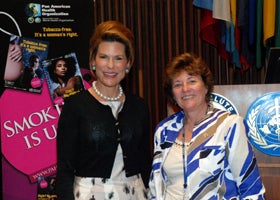
T o help protect women from the lethal effects of smoking, countries in the Americas should promptly implement tobacco control measures, including the total prohibition of publicity, promotion, and sponsorship by tobacco companies and protection against exposure to second-hand smoke, Pan American Health Organization (PAHO) Director Dr. Mirta Roses said today.
o help protect women from the lethal effects of smoking, countries in the Americas should promptly implement tobacco control measures, including the total prohibition of publicity, promotion, and sponsorship by tobacco companies and protection against exposure to second-hand smoke, Pan American Health Organization (PAHO) Director Dr. Mirta Roses said today.
Washington, June 2, 2010 (PAHO) — To help protect women from the lethal effects of smoking, countries in the Americas should promptly implement tobacco control measures, including the total prohibition of publicity, promotion, and sponsorship by tobacco companies and protection against exposure to second-hand smoke, Pan American Health Organization (PAHO) Director Dr. Mirta Roses said today.

Nancy G. Brinker, Founder, "Susan G Komen for the Cure" Foundation; and Dr. Mirta Roses, Director, PAHO
Dr. Roses added, "However, a great deal still remains to be done, and on World No Tobacco Day we appeal for the prohibition of all forms of publicity, promotion, and sponsorship of tobacco products, prohibitions on smoking in all public places and the workplace, and the need to take into account gender perspective in implementing the tobacco control policies.
Ambassador Nancy G. Brinker, founder of the Susan G. Komen for the Cure Foundation, in the keynote speech at today's event, said, "As globalization brings iPhones, movies, and fashion to the developing world, it also brings the dangers of destructive lifestyles and the lies of tobacco companies in need of new female customers. I know these lies because I heard them all — smoking makes you stylish or attractive or independent. No on all counts — smoking kills, plain and simple. It's stupid. It costs money. It hurts you and your families."
This year's World No Tobacco Day campaign aims to counter tobacco industry efforts to convince women that smoking can improve their image. Of the over 5 million people who die each year from tobacco use, approximately 1.5 million are women. Unless urgent action is taken, by 2030 tobacco use could kill more than 8 million people, of whom 2.5 million would be women. Approximately three-quarters of these female deaths would occur in the low- and middle-income countries that are least able to absorb such losses. Every one of these premature deaths would have been avoidable.
Although fewer women than men around the world use tobacco, current trends suggest that in many countries, girls and young women are cigarette makers' most promising potential growth market. A recent international study on smoking among young people found that in half of 151 countries surveyed, roughly as many girls smoked cigarettes as boys, and in some countries, more girls smoked than boys. In contrast, smoking by men is in slow decline in many countries.
Ambassador Brinker told participants at today's observance, "Whether it's a cigarette or a water pipe, tobacco doesn't discriminate . . . it is an equal opportunity killer. Tobacco companies, on the other hand, do discriminate, seeking to exploit development and attack where our defenses are weak. They see which countries make tobacco control a priority and which ones don't. They know exactly what we do, that tobacco use is growing fastest in low-income countries, which is why we must redouble our efforts where the battle is being fought."
She added, "Almost every trend is working against low- and middle-income nations. By the year 2030, these countries will bear 70 percent of the global cancer burden. That's not just a burden of grief; it's a heavy drag on a society's prospects for growth, prosperity and a future of hope. Low-income households spend over 10 percent of the family budget on tobacco . . . 10 percent. That's money that could be spent on food, clothing, education, or shelter."
Dr. Adriana Blanco, PAHO's regional advisor on tobacco control, noted that in some countries, the bigger threat to women is from exposure to the smoke of others, particularly men. Worldwide, of the 430,000 adult deaths caused every year by second-hand smoke, 64 percent occur in women.
To lure women into smoking, tobacco companies spend millions of dollars on marketing campaigns that associate smoking with power and independence, sexual attractiveness, or weight control.
The tobacco industry constantly and aggressively seeks new users to replace the ones who quit and the current users — up to half — who will die prematurely from cancer, heart attack, stroke, emphysema or other tobacco-related disease.
World No Tobacco Day 2010 focuses on the harm that tobacco marketing and smoke do to women. At the same time, it seeks to make men more aware of their responsibility to avoid smoking around the women with whom they live and work.
The WHO Framework Convention on Tobacco Control, in effect since 2005, acknowledges "the increase in smoking and other forms of tobacco consumption by women and young girls worldwide" and explicitly recognizes "the need for gender-specific tobacco control strategies."
Figures show that less than 9 percent of the world's population is covered by comprehensive advertising bans, and 5.4 percent is covered by comprehensive national smoke-free laws.
LINKS:
- World No Tobacco Day 2020 celebration photos
- World No Tobacco Day, May 31 2010: "Gender and tobacco with an emphasis on marketing to women"
- Video: Nancy Brinker, WHO Goodwill Ambassador for Cancer Control
- Video: Día Mundial Sin Tabaco - Protejamos a las mujeres de la promoción del Tabaco/Miss Paraguay Viviana Mabel Benitez (only in Spanish)
CONTACT: Daniel Epstein, Tel. +1 202 974 3459 Knowledge Management and Communication Area, PAHO/WHO.



